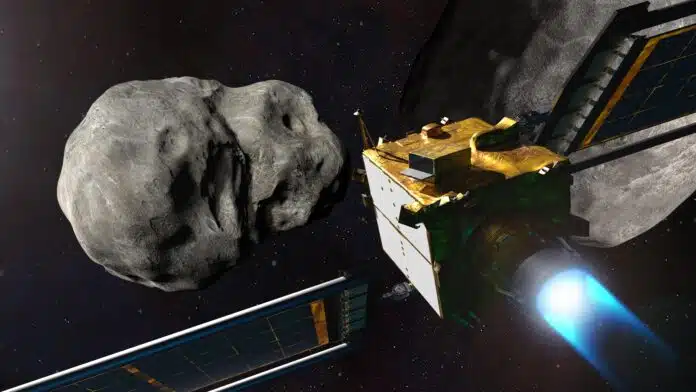
By Amit Malewar 24 Aug, 2024
Collected at: https://www.techexplorist.com/nasa-dart-mission-alters-asteroid-moons-shape-orbit/88376/
In 2022, NASA’s DART spacecraft collided with an asteroid moon called Dimorphos, deforming the moon and creating a large crater. The impact reshaped the moon so dramatically that it derailed from its original evolutionary progression.
According to scientists, Dimorphos may start to “tumble” chaotically in its attempts to move back into gravitational equilibrium with Didymos, its parent asteroid.
A new study by the University of Maryland offers details on post-impact observations and describes possible implications for future asteroid research.
One significant impact is that DART changed the shape of Dimorphos. Originally, the asteroid moon’s shape was oblate. After impact, it became more prolate.
Derek Richardson, a professor of astronomy at the University of Maryland and a DART investigation working group lead, said, “We were expecting Dimorphos to be prolate pre-impact simply because that’s generally how we believed the central body of a moon would gradually accumulate material that’s been shed off a primary body like Didymos. It would naturally tend to form an elongated body that would always point its long axis toward the main body.”
“But this result contradicts that idea and indicates that something more complex is at work here. Furthermore, the impact-induced change in Dimorphos’ shape likely changed how it interacts with Didymos.”
Although DART only hit the moon, the moon and its asteroid are linked by gravity. The debris from the impact also disturbed their balance, causing the moon, Dimorphos, to orbit its asteroid, Didymos, more quickly. Interestingly, Didymos didn’t change shape, showing it’s sturdy enough to stay solid even after losing material to form its moon.
According to Richardson, Dimorphos’ changes have important implications for future exploration efforts, including the European Space Agency’s follow-up mission to the Didymos system slated for October 2024.
“Originally, Dimorphos was probably in a very relaxed state and had one side pointing toward the main body, Didymos, just like how Earth’s moon always has one face pointing toward our planet,” Richardson explained. “Now, it’s knocked out of alignment, which means it may wobble back and forth in its orientation. Dimorphos might also be ‘tumbling,’ meaning that we may have caused it to rotate chaotically and unpredictably.”
The team is now waiting to see when the debris will clear if Dimorphos is still spinning, and when it will return to its previous stable state.
One significant question now is whether Dimorphos is stable enough for spacecraft to land and set up more research equipment. It might take a hundred years to see significant changes, but it’s only been a few years since the impact.
Understanding how long it takes Dimorphos to regain stability will provide important insights into its internal structure and help with future asteroid deflection efforts.
Scientists hope that Hera will provide more information about DART’s impact. By late 2026, Hera will arrive at the binary asteroid system containing Dimorphos and Didymos to assess the internal properties of both asteroids for the first time, providing a more detailed analysis of the DART mission and its implications for the future.
Journal Reference:
- Derek Richardson et al. The Dynamical State of the Didymos System Before and After the DART Impact. Planetary Science Journal. DOI 10.3847/PSJ/ad62f5

Leave a Reply